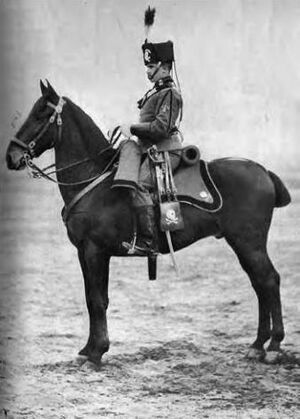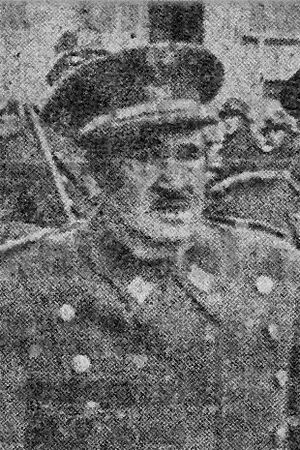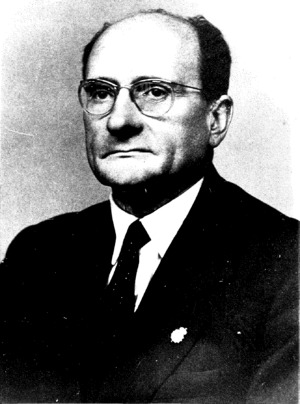Alejandro Utrilla Belbel facts for kids
Alejandro Utrilla Belbel (1889–1963) was a Spanish cavalry officer. He became a general during the early years of Franco's rule. He served as a military governor in places like Mallorca, La Coruña, and Valladolid. His most important role was in the early 1950s when he briefly led the VII Military Region.
Utrilla is best known for his key part in the anti-Republican plans in early 1936 in Navarre. As the local commander of the requeté (a Carlist militia), he helped quickly take control of the region. He also helped the rebel forces advance into Gipuzkoa and Aragón. Politically, he supported the Carlist cause. Besides leading the Navarrese militia, he was briefly part of the national Carlist party leadership in the mid-1940s. Later, he left the main Carlist group and joined a different Traditionalist group called Regencia de Estella.
Quick facts for kids
Alejandro Utrilla Belbel
|
|
|---|---|
|
|
|
| Born |
Alejandro Utrilla Belbel
1889 Alcalá la Real, Spain
|
| Died | 1963 (aged 73–74) Granada, Spain
|
| Nationality | Spanish |
| Occupation | professional officer |
| Known for | military |
| Political party | Carlism |
Contents
Who Was Alejandro Utrilla's Family?

The Utrilla family originally came from Northern Spain. In the Middle Ages, some family members lived in Villaviciosa in Asturias and in the mountains north of Burgos. One part of the family moved south during the Reconquista (when Christian kingdoms took back land from Muslim rule). They settled in Guadix, a town in what was then the Kingdom of Granada.
The first known ancestor, Miguel de Utrilla, moved to Alcalá la Real in the late 1500s. This town was built around an old fortress in what is now the province of Jaén, in Eastern Andalusia. His family became important citizens, serving as local officials. Over time, the family became wealthy, owning land and houses in Alcalá.
Alejandro's father, Juan Utrilla y Utrilla, owned a modest house in Alcalá. He worked as the head of postal services in Jaén in the early 1900s. Juan married Francisca Belbel Tapia (born 1860), who came from another well-known local family. Alejandro might have had one brother and two sisters.
Alejandro went to local schools. He decided to join the army, possibly influenced by his family's military background. In 1907, he joined the Academía Militar de Avila. In 1908, he was a first-year student at the Academía de Caballería (Cavalry Academy) in Valladolid. He finished his cavalry training and became a segundo teniente (second lieutenant) in 1910.
Alejandro married Consuelo León Brezosa (1895-1984) in the late 1910s. She was from Madrid and her father was a doctor from Andalusia. They had five children: Consuelo, Mercedes, Matilde, Alejandro, and Jaime. None of their children became famous public figures.
Alejandro Utrilla's Early Military Career
In 1910, Utrilla's first job in the army was with the Regimento de Caballería Dragones de Santiago in Barcelona. After about a year, in 1911, he was sent to Cazadores de Taxdirt, a combat unit in Morocco. At that time, Spanish troops were fighting against Berber tribes near the city of Melilla. This fighting became known as the Kert Campaign. Utrilla led a machine-gun section during the crossing of the Kert river.
In 1912, he was promoted to lieutenant (teniente primero). In early 1913, he moved to the Cazadores de Alcántara regiment. Later that year, he moved from frontline duty to a support role at Cuadro Eventual de Larache, a supply center for the unit.
In 1915, Utrilla joined the Cazadores de Lusitania regiment and returned to combat. He fought in the battle of Tauima that same year. When his unit's commander was hit, Utrilla personally led the charge against the enemy. This action was even mentioned in newspapers. In 1916, he was again put in charge of Cuadro Eventual de Ceuta. By 1919, he was a capitán (captain) and moved to different administrative roles. In 1921, he returned to frontline duty with the Cazadores de Tetuán regiment.
From 1922 to 1923, he served in units made up of local Moroccan volunteers, called Fuerzas Regulares Indígenas de Larache. During this time, he was part of a group of officers known as Grupo de Larache. This group included future famous figures like Enrique Varela and Manuel Goded.
In September 1923, Primo de Rivera took power in Spain. He wanted to fix the government and sent military inspectors (delegados gubernativos) to local areas. In December 1923, Utrilla was chosen for this role and sent to the Navarrese district of Aoiz. He was recalled from Navarre in December 1924 and returned to Morocco in early 1925.
Rising Through the Ranks
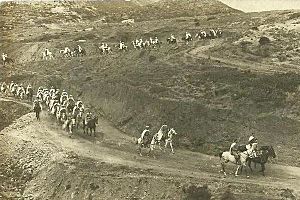
Back in Africa, Utrilla again led local troops, this time with Fuerzas Regulares Indígenas de Ceuta. In 1926, he was promoted to comandante (major). He was also recognized for his brave service. From early 1927, he commanded 3. Grupo de Fuerzas Regulares Indígenas de Ceuta, a unit similar to a regiment. This was his last assignment in Africa.
In late 1927, Utrilla moved back to Spain and joined the 2. Regimento de Lanceros Reina unit in Alcalá de Henares. He served there for over two years. In late 1929, Utrilla returned to Navarre. He was promoted to teniente coronel (lieutenant colonel) and became second-in-command of the Cazadores de Almansa regiment in Pamplona. He continued to serve in Pamplona during the fall of the dictatorship and the start of the Republic in 1930–1931.
The new republican government, led by Manuel Azaña, began to reform the army. One big change was how officers were promoted. Utrilla's promotion to teniente coronel was cancelled, and he was downgraded to comandante. However, he also received the Cruz de Merito Militar, second class. In late 1931 or early 1932, Utrilla left Navarre and moved to Barcelona. The government was also encouraging officers to retire to reduce the size of the army. In August 1932, Utrilla chose to retire and moved back to Alcalá la Real.
Joining the Conspiracy
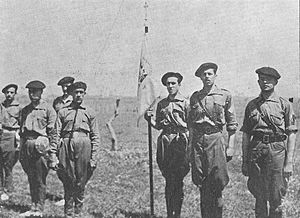
Many retired officers, unhappy with the government's army policies, started to plan against it. Utrilla was one of them, and he became close to the Carlists. By 1935, he openly identified as a Traditionalist. He wrote articles for the official Carlist newspaper, El Siglo Futuro. He also helped organize and train the Carlist militia, the requetés, in Eastern Andalusia. Some sources say he led the requeté organization in Andalusia.
In early 1936, Utrilla was made Inspector General of the Requeté in Navarre. His job was to reorganize and train the local militia. For several months, he recruited new members, made plans, led drills, and helped smuggle weapons. By late January, the force had grown to about 250 men. During the February 1936 elections, his men helped keep order in Pamplona. After the Popular Front won, Utrilla put his requeté on alert, expecting trouble.
In the spring of 1936, Utrilla joined the Carlist Supreme Military Junta and helped plan a rebellion. He was supposed to lead a Carlist-only uprising. This plan was stopped by state security. Utrilla was briefly arrested in June 1936 for having illegal weapons, but he was released because there was no proof. After that, he went into hiding and became part of the regional conspiracy command. He helped make the rebels in Navarre very effective and also got weapons for the Catalan Carlist group. In early July 1936, he ran a secret military academy in Pamplona, appointing officers in the name of the Carlist leader, Alfonso Carlos.
There was some disagreement between the local Carlist leaders in Navarre and the national command. Utrilla got along well with both groups. He was seen as a charismatic leader who could also help solve problems. On July 13, he told the requetés to only rise up if ordered by the militia leaders. As a senior officer, he also connected the Traditionalists with the main military plotter, General Mola. On July 14, he met Mola to discuss the Carlists' terms for joining the rebellion. On July 15, Utrilla ordered the Navarrese requeté to prepare for an uprising without a specific date. On July 18, the date was set for the next morning.
Role in the Civil War
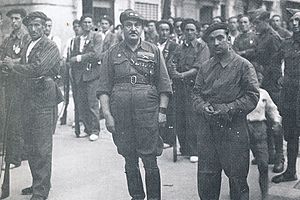
During the first four days of the uprising, Utrilla was the head of the Carlist regional general staff. He was busy organizing the many volunteers, forming units, appointing commanders, sending troops in different directions, and boosting morale with speeches. He also helped organize the rebellion in the nearby region of Álava.
His most important contribution was leading a column of 1,200 Navarrese requetés by train from Pamplona to Zaragoza on July 23. This was an urgent mission because the rebels' control over Zaragoza was very weak. Utrilla made sure the troops arrived quickly and helped the rebels take control of the city. With Jesús Comín, he also convinced the local rebel military commander, General Cabanellas, to replace the republican flag with the monarchist roja y gualda (red and gold) flag. In early August, he handed over command of the requeté troops in Zaragoza, which were named Tercio de María de las Nieves in honor of the Carlist queen. He then returned to Pamplona.
Utrilla spent most of August in Pamplona. On the last day of the month, he left for the Gipuzkoan front. In early September, he was back in combat for the first time since his Moroccan days in 1925. Near Irún, he commanded a mixed unit of requetés, Falangists, and soldiers. This unit was part of the Columna Los Arcos and attacked the fortified area of San Marcial. They took Behovia on September 4. In mid-September, he suggested moving some troops from Gipuzkoa to Aragón. After San Sebastián was captured, he led some requeté units to the East. He again commanded Tercio María de las Nieves, which was mostly defending positions along the Ebro river. Utrilla remained in charge until November.
It's not clear where Utrilla was during the winter of 1936-1937. In March 1937, he was listed in the official orders of the Nationalist high command. He was assigned to lead Cuadro Eventual of the 6. Division, which was being formed in Granada. A newspaper note from late 1937 praised his help in the successful Northern campaign, but gave no details. In June 1938, he was promoted to coronel de caballería (cavalry colonel).
After the War: Military Career

In the Francoist era, Utrilla held various military jobs, including administrative roles, commanding large units, and working in the military justice system. Most of these jobs lasted less than two years. In September 1939, as a teniente coronel, he was given his first post-war assignment: to lead 1. Brigada de Caballería in Alcalá de Henares.
In 1940, he was promoted to general de brigada (brigadier general) and remained in charge of the same cavalry unit. In May 1941, he became the military governor of the Mallorca province. He held this role for just over a year. In June 1942, he was appointed commander of the 93. division. This was the first time Utrilla commanded a unit that wasn't just cavalry. He was promoted to general de división in this role. In April 1945, Utrilla became Military Governor in the province of La Coruña. The following year, he commanded the 42. division. This was his last role commanding a large military unit.
In 1947, Utrilla was made a military advisor to the Consejo Supremo de Justicia Militar, the highest army military court. In 1948, he became military governor of the province of Valladolid for the third time. He was also made sub-inspector of the VII Región Militar. These were his longest assignments, lasting over four years. In 1949, he met Franco in person.
In 1952, Utrilla met Franco again. He was promoted to teniente general (lieutenant general) and became Capitán General of the Baleares. In December 1953, he returned to Old Castile as the supreme commander of the VII Región Militár, with headquarters in Valladolid. He remained in this position until late 1955. In the mid-1950s, he moved to a semi-retired status. In September 1959, Utrilla reached the regular military retirement age and officially retired from active service as a teniente general.
Later Carlist Activities
There isn't much information about Utrilla's direct involvement with the Traditionalists right after the war. However, he kept his ties to the Carlist party and tried to maintain their identity within the limits allowed by the government.
While stationed in Alcalá, he attended the 1941 Holy Week celebrations in Granada. These events had a strong Traditionalist feel, with groups of requeté veterans marching with their flags. The local Falange commander complained that the event became "a true political demonstration." Utrilla, who was present in the honorary tribune, did not intervene when people shouted "Long live the lions of the Requeté!"
During his service in Baleares in 1942, the Falangists reported that Utrilla supported a separate Carlist-only celebration of the Fiesta de los Mártires de la Tradición (Feast of the Martyrs of Tradition). He appeared in military uniform but wore the Carlist red beret instead of a peaked cap. He also helped Carlists who had been arrested. In 1943, he attended the Montserrat Aplec (gathering) with Carlist leaders. In 1945, at an event in Zaragoza, he received honors from and greeted a marching requeté group.
Utrilla's relationship with the Carlist leadership in the 1940s is not entirely clear. One source says he was appointed to the national Carlist executive in 1943. He remained on good terms with the regent-claimant, Don Javier. However, around the late 1940s and early 1950s, Utrilla started to lean towards the group led by Sivatte. This group criticized Don Javier for supposedly being too soft on the dictatorship. When Sivatte's followers left the main Carlist group in the mid-1950s and formed RENACE, Utrilla was considered a close supporter, though he didn't make public statements.
When Utrilla was semi-retired, he tried to attend Sivattista gatherings at Montserrat. One day before a rally in 1959, the Capitán General of Barcelona, Pablo Martín Alonso, offered him a high-paying job at a state-controlled company. In return, Utrilla was supposed to stop his political activities. He refused. The next day, Utrilla, who was a teniente general at the time, was arrested by military police and driven to Alcalá la Real.
Even after this, he continued to support the Sivattistas, but no longer in public. In the early 1960s, he believed that RENACE was the only group truly upholding Traditionalist values. He encouraged those who called themselves Traditionalists or Carlists to follow "the Regency of Estella, which today is the only legitimate Carlist authority."
See Also
 In Spanish: Alejandro Utrilla para niños
In Spanish: Alejandro Utrilla para niños
- Maurici de Sivatte i de Bobadilla
- Carlo-francoism
Images for kids
-
Cavalry Academy, Valladolid



